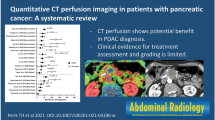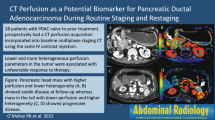Abstract
Purpose
Here, we evaluated the usefulness of intratumoral perfusion analysis using preoperative contrast-enhanced CT (E-CT) to assess biological features of non-functional pancreatic neuroendocrine neoplasms (NF-PanNENs).
Methods
We retrospectively studied 44 patients who underwent curative surgery for NF-PanNENs. We used preoperative E-CT with compartment model analysis to calculate the tumor perfusion parameters K1 (inflow rate constant), 1/k2 (mean transit time), and K1/k2 (distribution volume). We assessed the association between perfusion parameters and biological features of NF-PanNENs, including the WHO classification tumor histopathological grade and prognosis after surgery.
Results
Patients in this study had a neuroendocrine tumor (NET) G1 (n = 32) or NET G2 (n = 12). Neither NET G3 or NEC tumors were observed. Among perfusion parameters, K1 was the most accurate predictor of the high-grade tumor (AUC: 0.726). K1-low (< 0.028 s−1) was significantly associated with large tumors (≥ 20 mm) (p = 0.022), high mitotic index (p = 0.017), high Ki-67 index (p = 0.004), and lymphatic invasion (p = 0.025). Synchronous extra-pancreatic metastasis, including lymph node metastasis or liver metastasis, more frequently developed in K1-low patients than in K1-high patients (29% vs 4%, p = 0.025). Disease-free survival of patients with a K1-low tumor was poorer than that of patients with a K1-high tumor (p = 0.005). Furthermore, no patient with a K1-high tumor developed recurrence after initial surgery.
Conclusion
The perfusion parameters obtained using E-CT were significantly associated with biological features and prognosis of NF-PanNENs.




Similar content being viewed by others
References
Metz DC, Jensen RT (2008) Gastrointestinal neuroendocrine tumors: pancreatic endocrine tumors. Gastroenterology 135:1469–1492
Halfdanarson TR, Rabe KG, Rubin J et al (2008) Pancreatic neuroendocrine tumors (PNETs): incidence, prognosis and recent trend toward improved survival. Ann Oncol 19:1727–1733
Ito T, Igarashi H, Nakamura K et al (2015) Epidemiological trends of pancreatic and gastrointestinal neuroendocrine tumors in Japan: a nationwide survey analysis. J Gastroenterol 50:58–64
Dasari A, Shen C, Halperin D et al (2017) Trends in the incidence, prevalence, and survival outcomes in patients with neuroendocrine tumors in the United States. JAMA Oncol 3:1335–1342
Falconi M, Eriksson B, Kaltsas G et al (2016) ENETS consensus guidelines update for the management of patients with functional pancreatic neuroendocrine tumors and non-functional pancreatic neuroendocrine tumors. Neuroendocrinology 103:153–171
Howe JR, Merchant NB, Conrad C et al (2020) The North American Neuroendocrine Tumor Society consensus paper on the surgical management of pancreatic neuroendocrine tumors. Pancreas 49:1–33
Gratian L, Pura J, Dinan M et al (2014) Impact of extent of surgery on survival in patients with small nonfunctional pancreatic neuroendocrine tumors in the United States. Ann Surg Oncol 21:3515–3521
Sharpe SM, In H, Winchester DJ et al (2015) Surgical resection provides an overall survival benefit for patients with small pancreatic neuroendocrine tumors. J Gastrointest Surg 19:117–123
Yamamoto Y, Okamura Y, Uemura S et al (2017) Vascularity and tumor size are significant predictors for recurrence after resection of a pancreatic neuroendocrine tumor. Ann Surg Oncol 24:2363–2370
Kasai Y, Masui T, Nakakura EK et al (2022) Preoperative risk stratification of lymph node metastasis for non-functional pancreatic neuroendocrine neoplasm: an international dual-institutional study. Pancreatology 22:123–129
Arai T, Kobayashi A, Fujinaga Y et al (2016) Contrast-enhancement ratio on multiphase enhanced computed tomography predicts recurrence of pancreatic neuroendocrine tumor after curative resection. Pancreatology 16:397–402
Rodallec M, Vilgrain V, Couvelard A et al (2006) Endocrine pancreatic tumours and helical CT: contrast enhancement is correlated with microvascular density, histoprognostic factors and survival. Pancreatology 6:77–85
d'Assignies G, Couvelard A, Bahrami S et al (2009) Pancreatic endocrine tumors: tumor blood flow assessed with perfusion CT reflects angiogenesis and correlates with prognostic factors. Radiology 250:407–416
Poultsides GA, Huang LC, Chen Y et al (2012) Pancreatic neuroendocrine tumors: radiographic calcifications correlate with grade and metastasis. Ann Surg Oncol 19:2295–2303
Sahani DV, Kalva SP, Hamberg LM et al (2005) Assessing tumor perfusion and treatment response in rectal cancer with multisection CT: initial observations. Radiology 234:785–792
Purdie TG, Henderson E, Lee TY (2001) Functional CT imaging of angiogenesis in rabbit VX2 soft-tissue tumour. Phys Med Biol 46:3161–3175
Sahani DV, Holalkere NS, Mueller PR et al (2007) Advanced hepatocellular carcinoma: CT perfusion of liver and tumor tissue--initial experience. Radiology 243:736–743
Iida Y, Konishi J, Harioka T et al (1983) Thyroid CT number and its relationship to iodine concentration. Radiology 147:793–795
Suzuki T, Yamada A, Komatsu D et al (2018) Evaluation of splenic perfusion and spleen size using dynamic computed tomography: usefulness in assessing degree of liver fibrosis. Hepatol Res 48:87–93
Yamada A (2014) Quantitative evaluation of liver function within MR imaging. In: El-Baz A, Saba L, Suri J (eds) Abdomen and thoracic imaging. Springer, Boston, MA. https://doi.org/10.1007/978-1-4614-8498-1_9
Gill AJ, Klimstra DS, Lam AK et al (2019) Neuroendocrine neoplasms (5th edition), The WHO Classification of Tumours Editorial Board. In: WHO Classification of the tumors, vol 1. IARC, Lyon, pp 343–370
Kim SH, Kamaya A, Willmann JK (2014) CT perfusion of the liver: principles and applications in oncology. Radiology 272:322–344
Small WC, Nelson RC, Bernardino ME et al (1994) Contrast-enhanced spiral CT of the liver: effect of different amounts and injection rates of contrast material on early contrast enhancement. Am J Roentgenol 163:87–92
Bae KT (2003) Peak contrast enhancement in CT and MR angiography: when does it occur and why? Pharmacokinetic study in a porcine model. Radiology 227:809–816
Tofts PS, Brix G, Buckley DL et al (1999) Estimating kinetic parameters from dynamic contrast-enhanced T(1)-weighted MRI of a diffusable tracer: standardized quantities and symbols. J Magn Reson Imaging 10:223–232
Park CM, Goo JM, Lee HJ et al (2009) FN13762 murine breast cancer: region-by-region correlation of first-pass perfusion CT indexes with histologic vascular parameters. Radiology 251:721–730
Couvelard A, O'Toole D, Turley H et al (2005) Microvascular density and hypoxia-inducible factor pathway in pancreatic endocrine tumours: negative correlation of microvascular density and VEGF expression with tumour progression. Br J Cancer 17(92):94–101
Takahashi Y, Akishima-Fukasawa Y, Kobayashi N et al (2007) Prognostic value of tumor architecture, tumor-associated vascular characteristics, and expression of angiogenic molecules in pancreatic endocrine tumors. Clin Cancer Res 13:187–196
Battistella A, Partelli S, Andreasi V et al (2022) Preoperative assessment of microvessel density in nonfunctioning pancreatic neuroendocrine tumors (NF-PanNETs). Surgery 172:1236–1244
Landoni L, Marchegiani G, Pollini T et al (2019) The evolution of surgical strategies for pancreatic neuroendocrine tumors (Pan-NENs): time-trend and outcome analysis from 587 consecutive resections at a high-volume institution. Ann Surg 269:725–732
Partelli S, Mazza M, Andreasi V et al (2019) Management of small asymptomatic nonfunctioning pancreatic neuroendocrine tumors: Limitations to apply guidelines into real life. Surgery 166:157–163
Lopez-Aguiar AG, Ethun CG, Zaidi MY et al (2019) The conundrum of < 2-cm pancreatic neuroendocrine tumors: a preoperative risk score to predict lymph node metastases and guide surgical management. Surgery 166:15–21
Acknowledgements
We thank Edanz (https://jp.edanz.com/ac) for editing a draft of this manuscript.
Author information
Authors and Affiliations
Contributions
TN, AS, AY, YF and YS were involved in study design and data interpretation. TN and AY were involved in the drafting of the article. TN, KK, SS, KU, TG and AY were involved in the data analysis. YS was involved in the study supervision. All authors critically revised the report, commented on drafts of the article, and approved the final report.
Corresponding author
Ethics declarations
Conflict of interest
The authors declare no competing interests.
Additional information
Publisher’s Note
Springer Nature remains neutral with regard to jurisdictional claims in published maps and institutional affiliations.
Supplementary information
Rights and permissions
Springer Nature or its licensor (e.g. a society or other partner) holds exclusive rights to this article under a publishing agreement with the author(s) or other rightsholder(s); author self-archiving of the accepted manuscript version of this article is solely governed by the terms of such publishing agreement and applicable law.
About this article
Cite this article
Notake, T., Shimizu, A., Kubota, K. et al. Usefulness of intratumoral perfusion analysis for assessing biological features of non-functional pancreatic neuroendocrine neoplasm. Langenbecks Arch Surg 409, 38 (2024). https://doi.org/10.1007/s00423-023-03219-2
Received:
Accepted:
Published:
DOI: https://doi.org/10.1007/s00423-023-03219-2





